When Jane Orvis and Steve Hanson bought their 1950s house in Seward Park, Seattle, they kept the original pink-tiled bathroom. But what about the mid-century shrubbery, arranged around a lawn—did that have to stay? Most people would reply, “absolutely not,” but Jane, who is a keen gardener, wanted to take a more closed-loop approach and consulted with the landscape architect Jonathan Hallett, of Supernature. On a joint visit to the Seattle Arboretum, a trio of plants in the New Zealand garden caught their attention: a topiarist’s hebe, a manzanita, and a kiwi tussock grass. They had all the “lightness and air and movement” that Jane’s garden was in need of.
“We stuck with the desaturated greens and off-greens typical of New Zealand plants,” says Jonathan. “We were trying to make it feel more like a dry garden, which it is.” He and Jane also planted natives, and plants from the coasts of Oregon and Northern California. “The overall tough and dry plant palette helped in creating a more climate-adapted garden that will tolerate Seattle’s increasingly long, dry and hot summers, with little supplemental irrigation required.”
“Most garden plants used in the Pacific Northwest are borrowed from Japanese or East Coast or British styles—plants like hydrangea that want summer water, which we don’t have,” says Jonathan. “Seattle has long, hot summers with a Mediterranean climate and we wanted to make a garden that was ready for that. We also tried to give it plenty of evergreen structure, so it feels full and good in the winter.”
Below, Jonathan explains what went into this mid-century landscape makeover.
Before
Above: The former front garden: A static combination of shaped bright greens and pinks in front of the mid-century house. “The typical landscape of the 1970s was lumps and lawn,” says Jonathan. “We wanted to break that up and we knew the lawn was always going to go. It was thirsty and spongey and wasn’t needed—and it was taking all the flat real estate that we wanted for making a lively counterpoint with plants.”
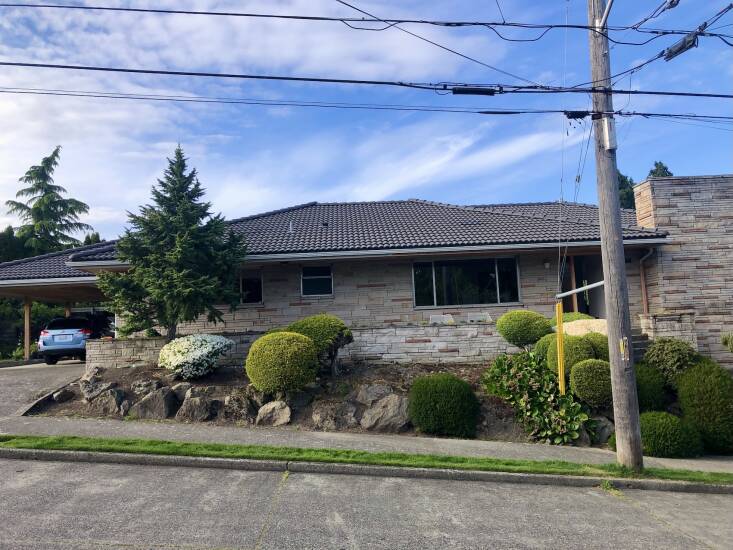 Above: “So many topiaries were removed and yet it still feels like there’s a lot,” he says.
Above: “So many topiaries were removed and yet it still feels like there’s a lot,” he says.
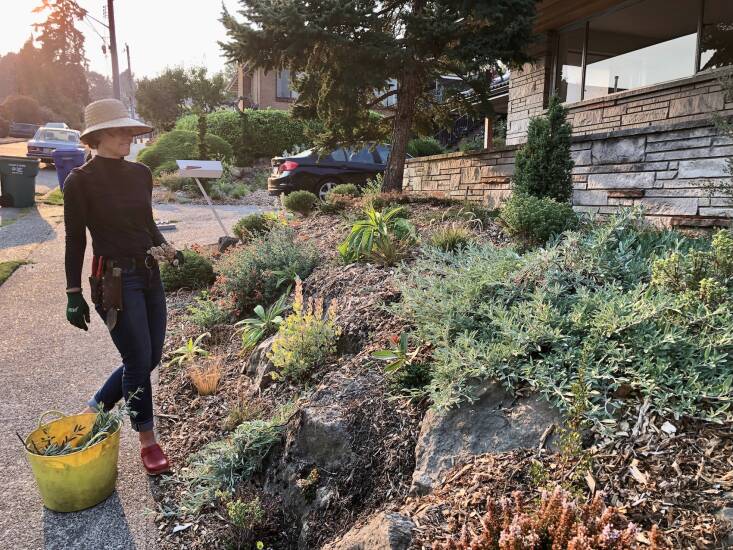 Above: Jane at work planting a climate-adapted “revisionist” garden to supplement the topiary blobs. “We wove in New Zealand plants throughout, and certain trios of plants together—so that while other plants or atmospheres come into the picture, we held that thread to give it unity.”
Above: Jane at work planting a climate-adapted “revisionist” garden to supplement the topiary blobs. “We wove in New Zealand plants throughout, and certain trios of plants together—so that while other plants or atmospheres come into the picture, we held that thread to give it unity.”
After
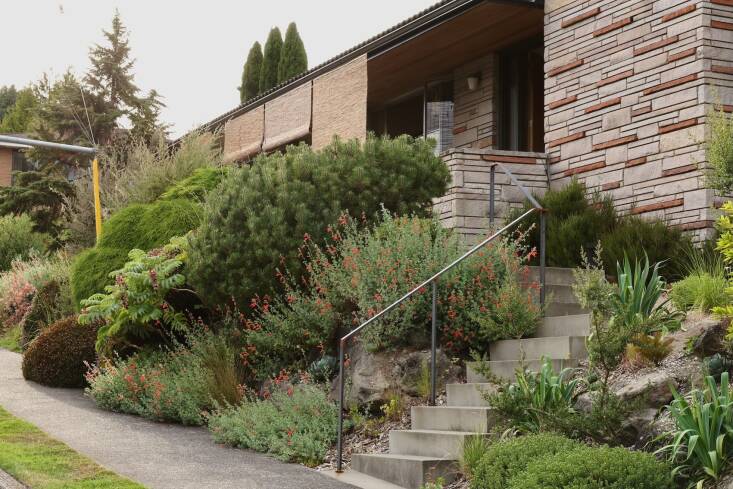 Above: Jane’s front garden is now an Antipodean-West Coast “pastiche” of a dry mountainside.
Above: Jane’s front garden is now an Antipodean-West Coast “pastiche” of a dry mountainside.
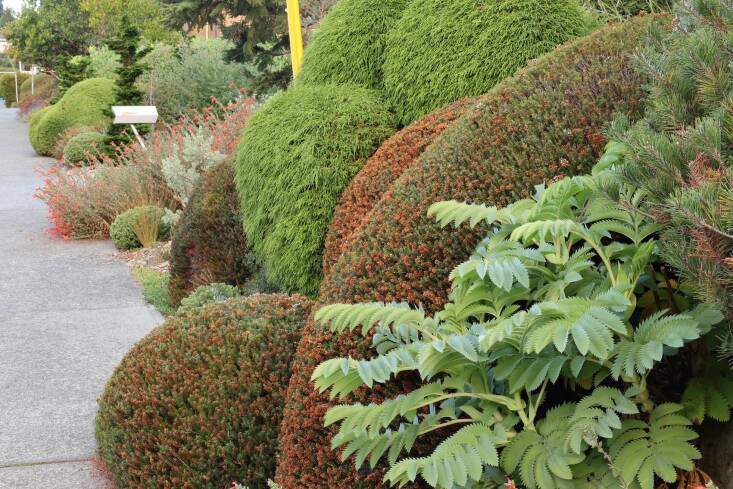 Above: Jane is a “casual ripper outer” but Jonathan convinced her to keep the turtle-shaped topiary at the rear left. “There are some strong and lovely topiaries. With fewer overall, some of these individuals or combos have more breathing room to be special,” he says.
Above: Jane is a “casual ripper outer” but Jonathan convinced her to keep the turtle-shaped topiary at the rear left. “There are some strong and lovely topiaries. With fewer overall, some of these individuals or combos have more breathing room to be special,” he says.
 Above: New curb appeal. Jane talking to the neighbors outside her Wilkeson sandstone-clad home. The house is a “well done but not unusual” mid-century style, in Jonathan’s words. “It pushed us to wanting more fluffy planting as a counterpoint to the heaviness of the stone-clad structure.” Australian tea trees, still young, will add some Dr Seuss atmosphere, being similar in shape to “truffula” trees.
Above: New curb appeal. Jane talking to the neighbors outside her Wilkeson sandstone-clad home. The house is a “well done but not unusual” mid-century style, in Jonathan’s words. “It pushed us to wanting more fluffy planting as a counterpoint to the heaviness of the stone-clad structure.” Australian tea trees, still young, will add some Dr Seuss atmosphere, being similar in shape to “truffula” trees.
 Above: “We removed an old concrete stair and put in new concrete step blocks that could tie into the remaining existing concrete and look casual,” says Jonathan. “There was not a lot of hard material re-use but not a lot of destruction either. We kept what made sense and was in good shape.”
Above: “We removed an old concrete stair and put in new concrete step blocks that could tie into the remaining existing concrete and look casual,” says Jonathan. “There was not a lot of hard material re-use but not a lot of destruction either. We kept what made sense and was in good shape.”
 Above: The garden has a view of the lake, one block away. The soil is heavy sediment and clay. “Many gardens in this neighborhood rely on excavating site soil and replacing it with imported soils that traditional garden plants won’t complain about,” says Jonathan. “We wanted to take a lower-impact approach, minimally removing site soil and instead using clay-tolerant plants. It has meant some experimenting with plants that will—and won’t—thrive in these conditions.”
Above: The garden has a view of the lake, one block away. The soil is heavy sediment and clay. “Many gardens in this neighborhood rely on excavating site soil and replacing it with imported soils that traditional garden plants won’t complain about,” says Jonathan. “We wanted to take a lower-impact approach, minimally removing site soil and instead using clay-tolerant plants. It has meant some experimenting with plants that will—and won’t—thrive in these conditions.”
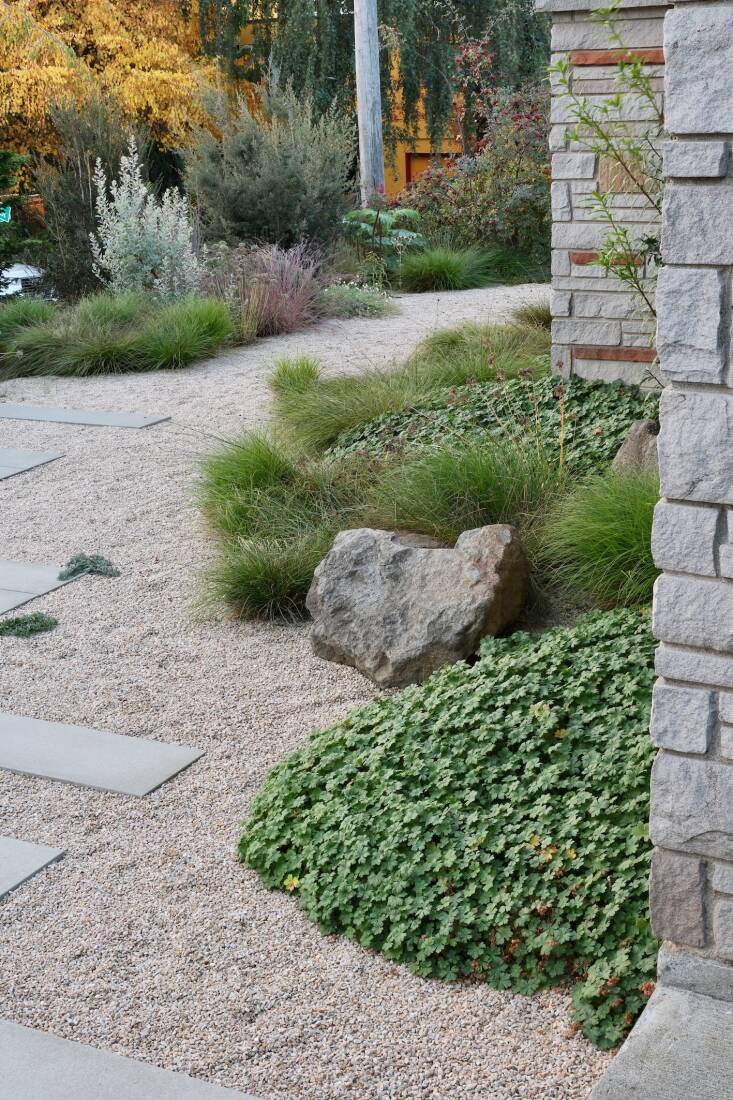 Above: A boulder dug out from the driveway has been re-sited in the gravel garden. “Most of the original concrete was left as is,” says Jonathan. “We replaced the crumbling concrete driveway with a permeable concrete paver surface. A couple boulders emerged from the driveway in the process and we added these to the landscape.”
Above: A boulder dug out from the driveway has been re-sited in the gravel garden. “Most of the original concrete was left as is,” says Jonathan. “We replaced the crumbling concrete driveway with a permeable concrete paver surface. A couple boulders emerged from the driveway in the process and we added these to the landscape.”
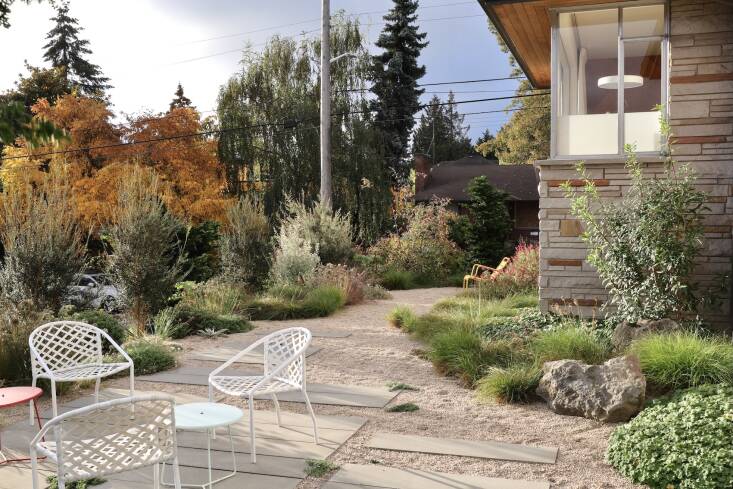 Above: The gravel garden (formerly the lawn) in fall. It’s still an area for “gathering and lounging.”
Above: The gravel garden (formerly the lawn) in fall. It’s still an area for “gathering and lounging.”
One last point on the subject of maintaining a revised, rather than new, garden, in Jonathan’s words: “Jane spends three hours max gardening per week and it looks very cared for.”
For more garden transformations, see:



